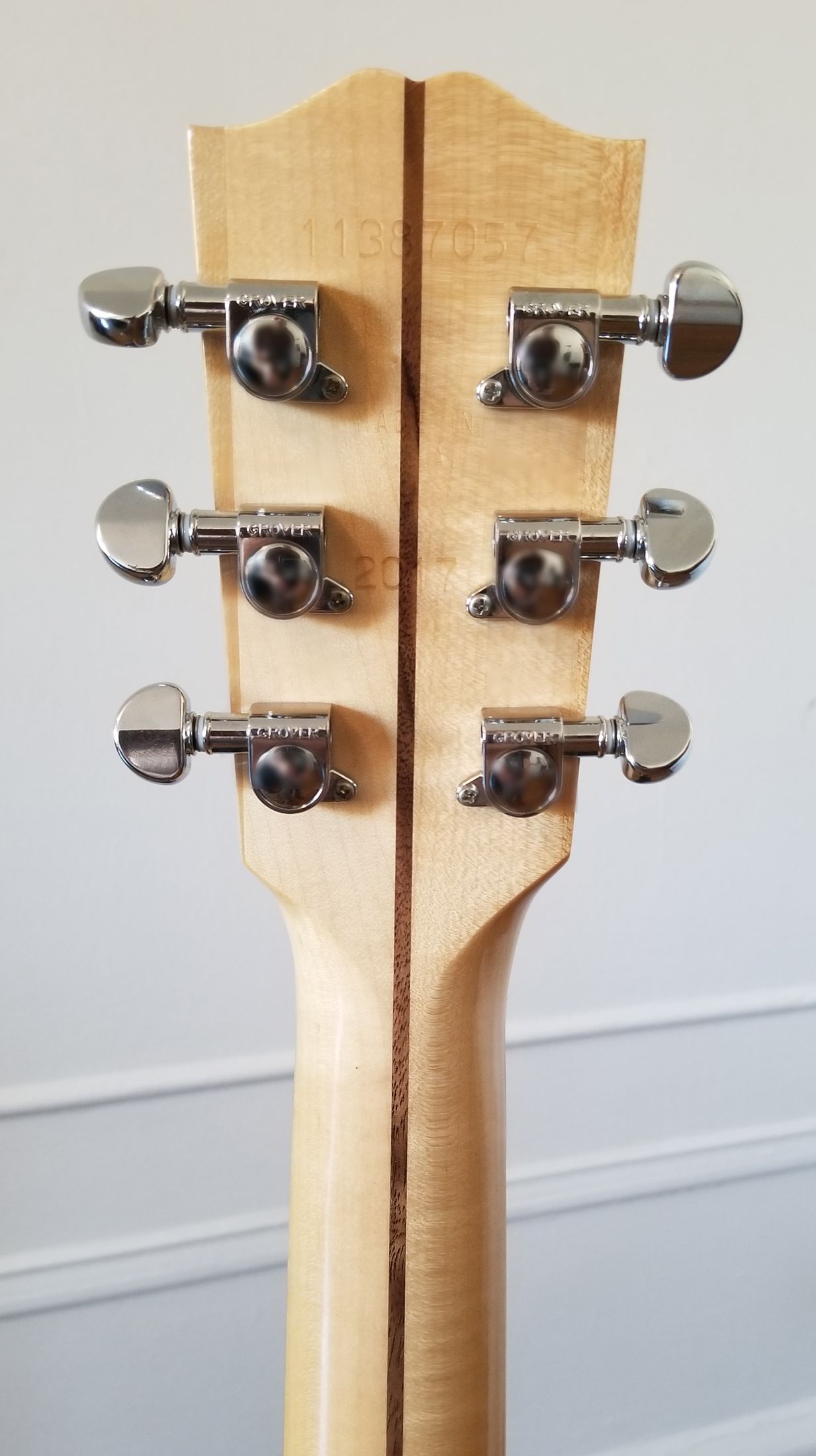Mellow walnut makes the Gibson J-15 one jovial jumbo
An environmentally friendly take on the classic J-45, the J-15 is a future-forward guitar
Specifications include: Standard Jumbo body size; solid walnut back and sides; solid Sitka spruce top with scalloped braces, Antique Natural toner, abalone sound hole rosette; two-piece solid maple neck with Slim Taper profile, dovetail neck joint fitted with hot hide glue; solid walnut fingerboard with 1.725” width at the Tusq nut, mother-of-pearl position markers; solid walnut slotted rectangular bridge with compensated Tusq saddle and decorative mother-of-pearl dots; antique ivoroid binding; nitrocellulose finish; gold Gibson headstock logo on a black field with a black truss rod plate; Grover Mini Rotomatic tuning machines
The J-15 has an agile voice with a combination of tonal properties heard only from walnut. Articulate without being strident, the woolly warmth fleshing out the quintessentially “Gibson” hollow log thunk in the bass is complimented by a dry and punchy mid-range, cheerful trebles, and angelic high harmonics with the subtle yet complex coloring unique to that particular tonewood.
American Made from American Wood
Gibson’s J-15 Standard is a Jumbo size acoustic-electric guitar, the 15 hearkening to the venerable J-45, which has many of the same construction specifications, including the standard side depth. But the J-15 Standard also contains a combination of tonewoods and appointments unique to this model.
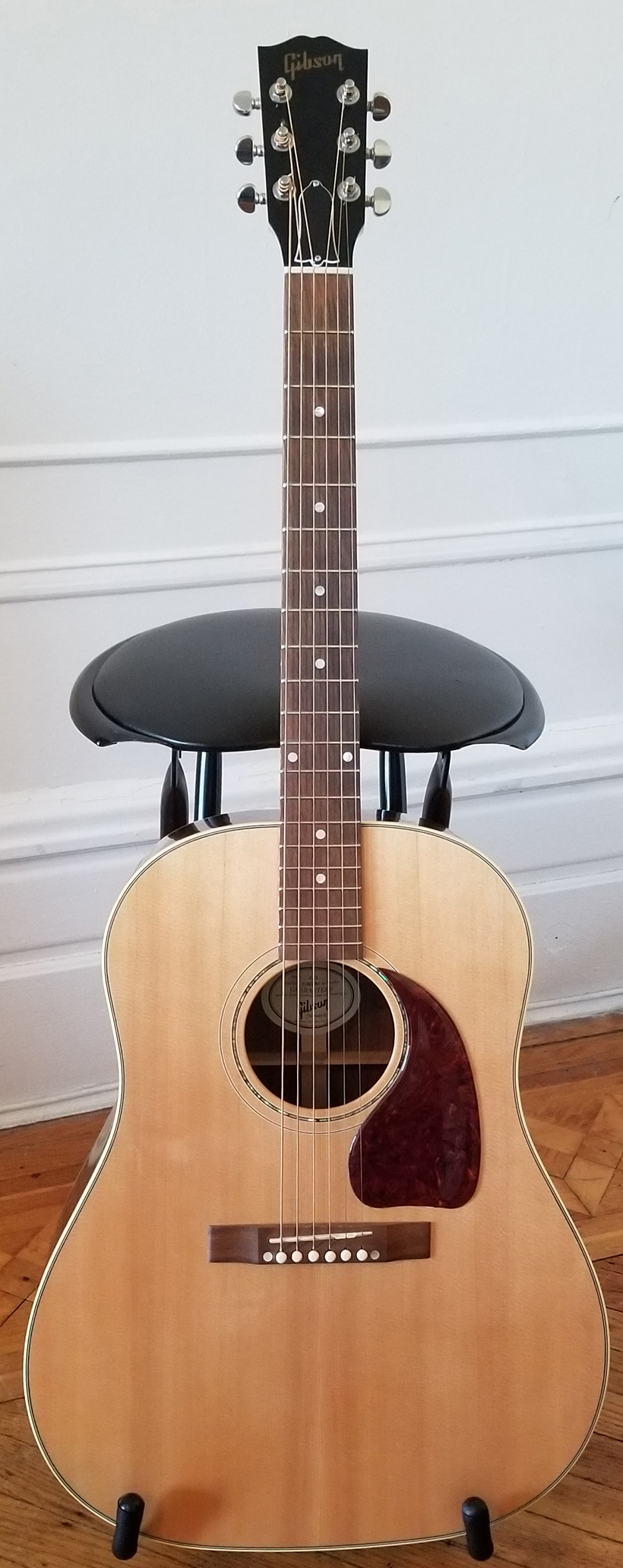 The most notable difference between the classic J-45 design and this departure into modern luthiery is seen and heard in the tonewoods used to create them. The back and sides of the J-15 are solid American walnut, rather than the tropical mahogany used to make a J-45. Walnut is similar to mahogany in hardness, while providing a bit more presence to the mid-range fundamentals, with a very fast reflection similar to maple, but with more of a warm glow around the bottom end notes that some equate to sounding more like rosewood, and with the high-overtone brilliance similar to Hawaiian koa wood, although not quite as complex. The Sitka spruce top has the dynamic range to project all three registers out into the room no matter how hard or soft the guitar is played, while further accentuating the warmth wreathing the low-mids and bottom end.
The most notable difference between the classic J-45 design and this departure into modern luthiery is seen and heard in the tonewoods used to create them. The back and sides of the J-15 are solid American walnut, rather than the tropical mahogany used to make a J-45. Walnut is similar to mahogany in hardness, while providing a bit more presence to the mid-range fundamentals, with a very fast reflection similar to maple, but with more of a warm glow around the bottom end notes that some equate to sounding more like rosewood, and with the high-overtone brilliance similar to Hawaiian koa wood, although not quite as complex. The Sitka spruce top has the dynamic range to project all three registers out into the room no matter how hard or soft the guitar is played, while further accentuating the warmth wreathing the low-mids and bottom end.
The fingerboard and bridge are also made from solid walnut. Much lighter in weight and hardness than the tropical rosewood used on the J-45, they play their own part in the particular tone of the J-15. This is mainly true for the bridge, which filters the physical energy coming from the strings on its way into the spruce soundboard. It is also a narrow rectangular bridge, with a much smaller footprint then the belly bridges used on many other Gibsons.
Instead of a one-piece mahogany neck, the J-15 has a two-piece neck made from solid maple with a decorative walnut strip running down its center. The blonde of the maple neck stands out from the darker stain used on the body, giving the guitar an extra-special appearance when seen from the back.
Walnut is prized for its beautiful grain, and it makes for some exceptionally attractive guitars. The walnut on this particular J-15 has a traditional look, rather than dramatic Rorschach patterns seen on other examples. While some say walnut sounds like a cross between rosewood and mahogany, this walnut looks the part with its layers of long relatively straight grain. It has dark rosewood-like stain that brings out the rosewood-like veins that streak up the back in a large, wide V pattern, but the lighter background is strewn with peppery flecks and subtle grain fluctuations similar figured mahogany. Up close, the combination of flecks and stripes remind me of the pelt of some large cat, like a lynx.
The bookmatching is very good indeed. This includes the Sitka spruce top, which has identical racing stripes running parallel to the strings, outside the bridge, made of three fine, straight, evenly spaced grain lines, so it looks like one wide stripe with a center seam. These and other details in the grain of the spruce are darkened and brought out visually by the Natural Antique top toner used on this model. But for the most part, the toner gives the soundboard only a slightly “aged” appearance.
The J-15 model is also available in a Walnut Burst top shading, resembling the various amber sunbursts offered by other guitar makers. The maple neck has its own grain patterns, as thin as spider webbing, running the full length from headstock to heel.
When it comes to wood-lovers’ druthers, the natural patterns and complementary hues of these tonewoods work wonderfully well together, just as they do when it comes to sound. The J-15 has a charming, woody voice that is 100% Gibson in its nature, yet very much with its own pleasing personality.
The Woolly Warmth of Walnut
The big, slope-shoulder sound chamber the defines the jumbo design makes great use of walnut’s way with mid-range presence and round bottom end sound. “Mellow” is the term that comes to mind every time I play this guitar. Even with brand new strings, it sounds like an old guitar that’s been thumping away for decades.
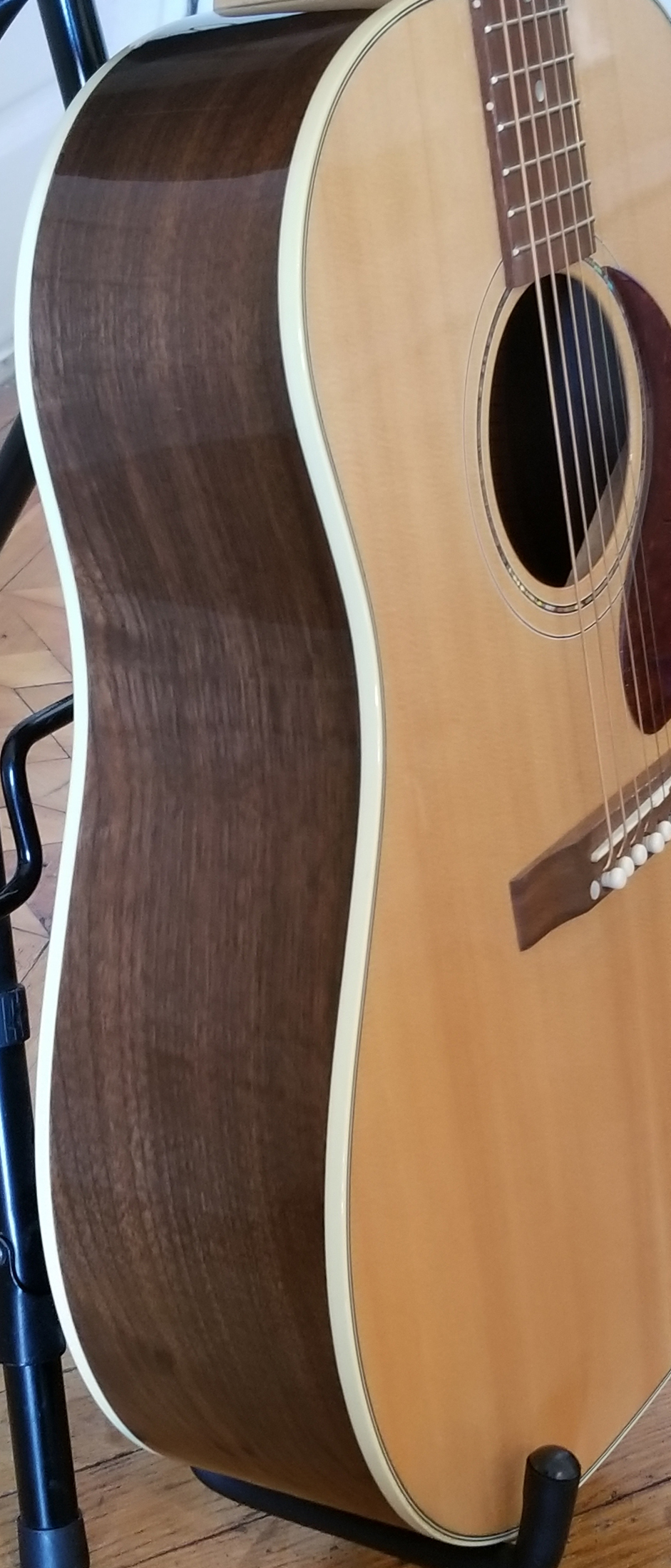 There is the abrupt Gibson thunk and thud to the bass strings as they kick off sweeping strums that stutter across the more-focused mid-range strings, and finish with a flourish of pretty, ethereal trebles leaping quickly out of the gate to ring with cheerful purity. The high-end clarity seems all the more distinct compared to the soft, round edges of those warm bass notes.
There is the abrupt Gibson thunk and thud to the bass strings as they kick off sweeping strums that stutter across the more-focused mid-range strings, and finish with a flourish of pretty, ethereal trebles leaping quickly out of the gate to ring with cheerful purity. The high-end clarity seems all the more distinct compared to the soft, round edges of those warm bass notes.
Walnut has fast reflection and very good fundamental sustain, so it works very well with the classic Gibson sound of fundamentals-forward while sympathetic response decays quickly into the background. The cocoon of glowing warmth that walnut puts around the unwound strings does not muddy things up. There is a staccato dryness when picking out notes. And during strumming, the main notes off the strings remain distinct even with their softer edges. And the unwound trebles are always bright and precise as they punctuate the broader, softer radiation of the lower registers.
Here is a voice as mellow as cup of creamy coffee and as comforting as a dignified, affectionate St. Bernard. It is round and satisfying in the bottom end; with a friendly, straight-forward bark in the mid-range, but ever accompanied by the jangling chimes of a clearly focused treble, always adding an uplifting and clarifying light atop it all. Not as dark or metallic as rosewood nor as deep or sunny as mahogany, the walnut voice floats and projects effortlessly, with nothing harsh or heavy about it.
Walnut is one of those other tonewoods, even if it has been around forever. It has its own kind of dryness. It has its own colorful highs, its own kind of fullness in the mid-range fundamentals, perhaps made a bit airier in this case by that very hard maple neck; and it has its own apparitions of subtle harmonic complexity haunting in and around the main notes. This is my first experience with a Gibson jumbo made from walnut. The closest thing I can equate it with would be a walnut Lowden, when it comes to its walnut-ness.
Walnut guitars share particular tonal properties, no matter who built them. Gibson jumbos, on the other hand, share a certain kind of sound all to themselves, no matter the wood employed. They have a jangly top end and that abrupt thunk to the bass that decays quickly, leaving the mid-range humming away under those sprightly overtones. And here is a Gibson jumbo made with walnut back and sides, and bridge and fingerboard for that matter, as well as a dense maple neck that helps to lighten up the whole voice. It all adds up to something a little different, yet familiar, and totally successful as a musical experience.
No Skimping on the Details
The 1 in the model name might suggest a lower level of specifications compared to the J-45. But there are so many pleasing elements to the design of the J-15 that it offers a modern alternative that is different from, not lower than, the J-45. The big exception here being the price, which is significantly lower, by nearly $1,000.
Most of that is explained by the lower production costs of using North American tonewoods compared to those that must be sought from the steaming jungles of Africa and South America. A little more savings can be found in the different L. R. Baggs pickup systems. The one in the J-15 has their usual undersaddle pickup with a single volume control hidden inside the sound hole. But one might never guess the J-15 was considered a “more affordable” jumbo when they walk into a guitar shop and see just how impressive it looks.
My hat is tipped to Gibson for designing such an aesthetically enjoyable guitar, which has white body binding, tinted to seem like ivory that has seasoned for decades, to go along with the Natural Antique top coat. And it is nice to see such a reasonably priced guitar with real mother-of-pearl fret position markers, rather than plastic, and a colorful sound hole rosette of iridescent abalone shell. It is inlaid as a tastefully thin ring that reminds me of the corona around a solar eclipse, orbited by a narrow three-ply black and white outer ring, which matches the two-ply purfling along the edge of the spruce top. I also like the thickness and coloring of the beveled faux-tortoise shell pickguard, the black headstock face plate on the stylish Gibson headstock with its classic gold Gibson logo and bell-shaped truss rod cap, and the chrome Grover Mini’s used for the tuning machines.
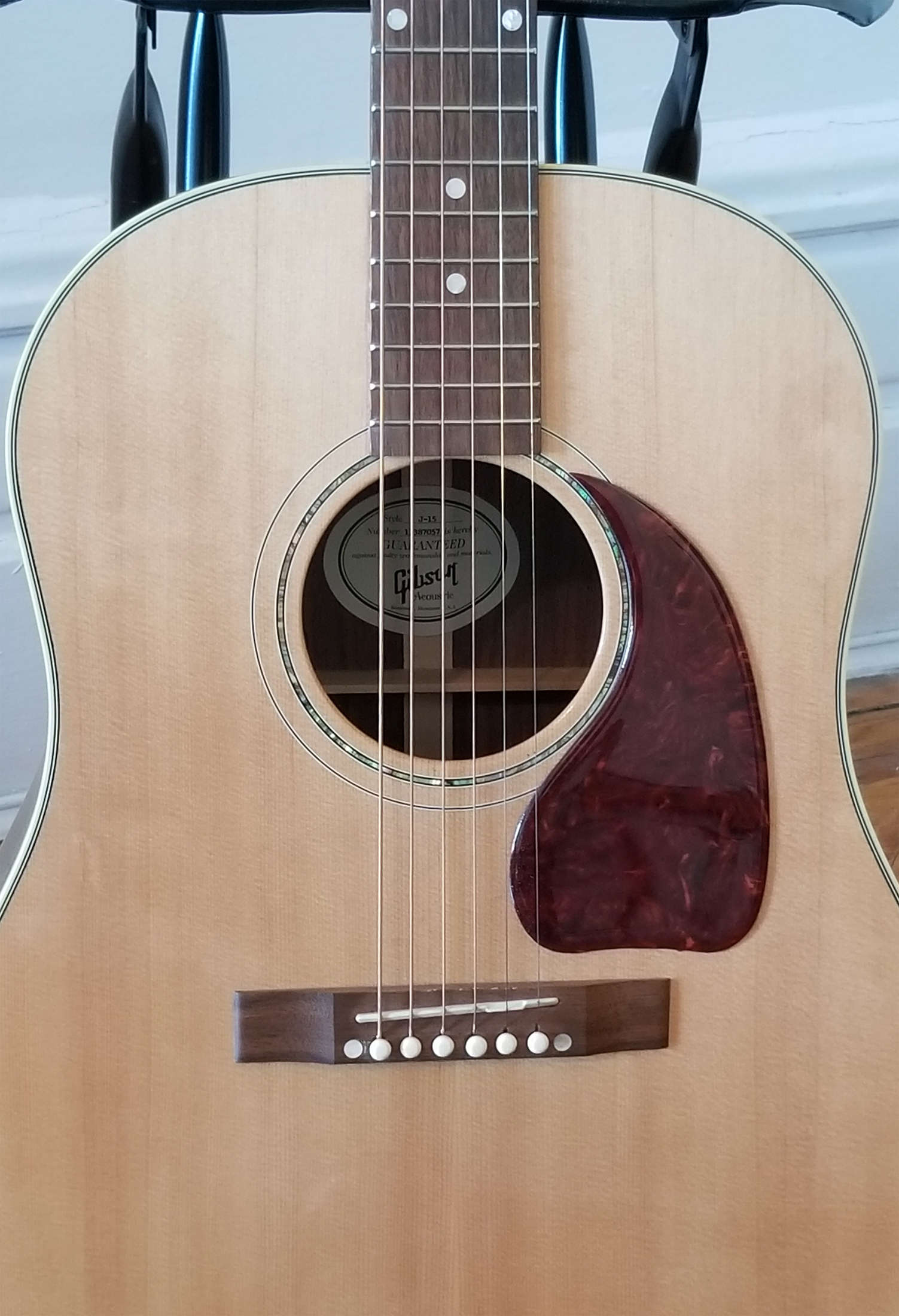 |
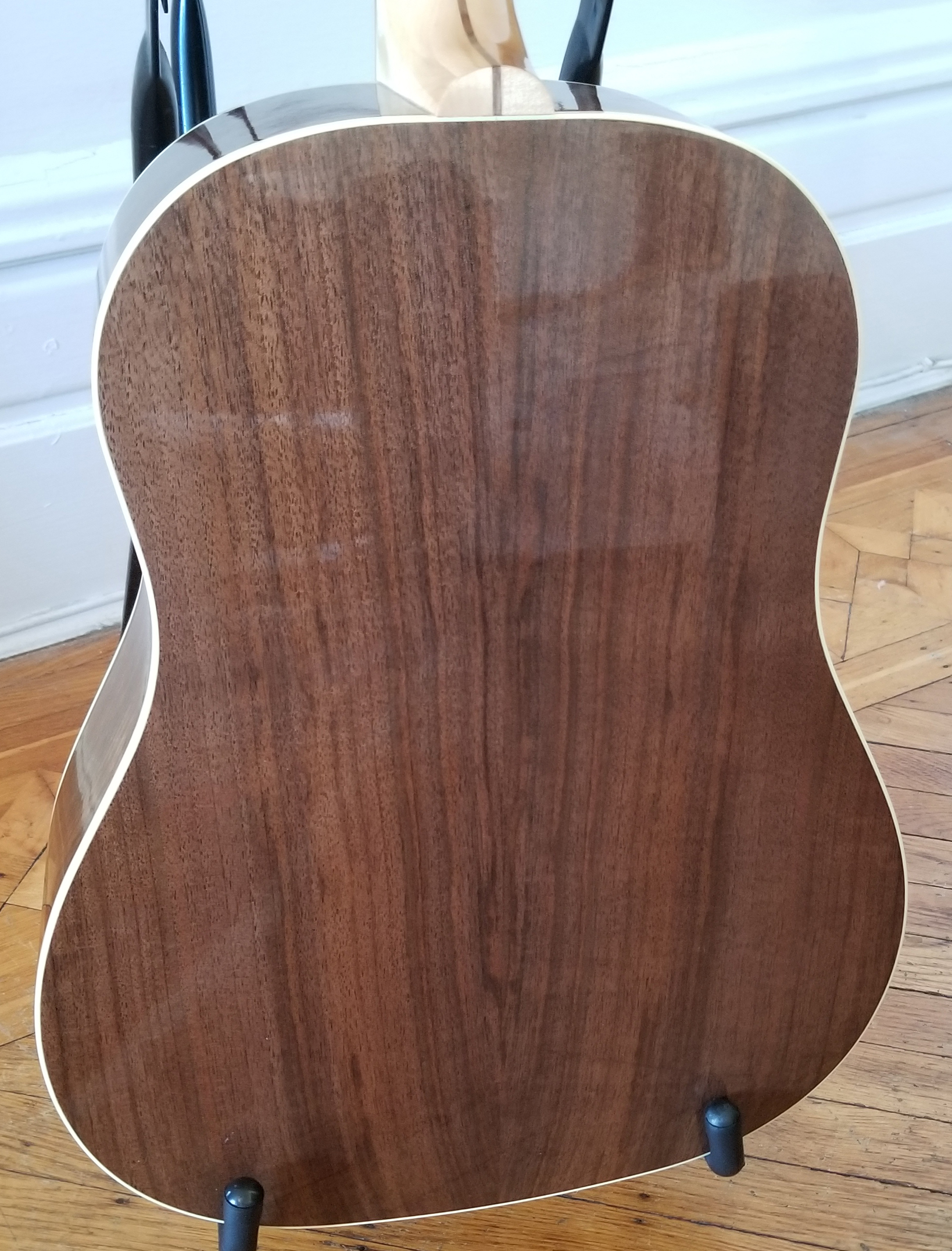 |
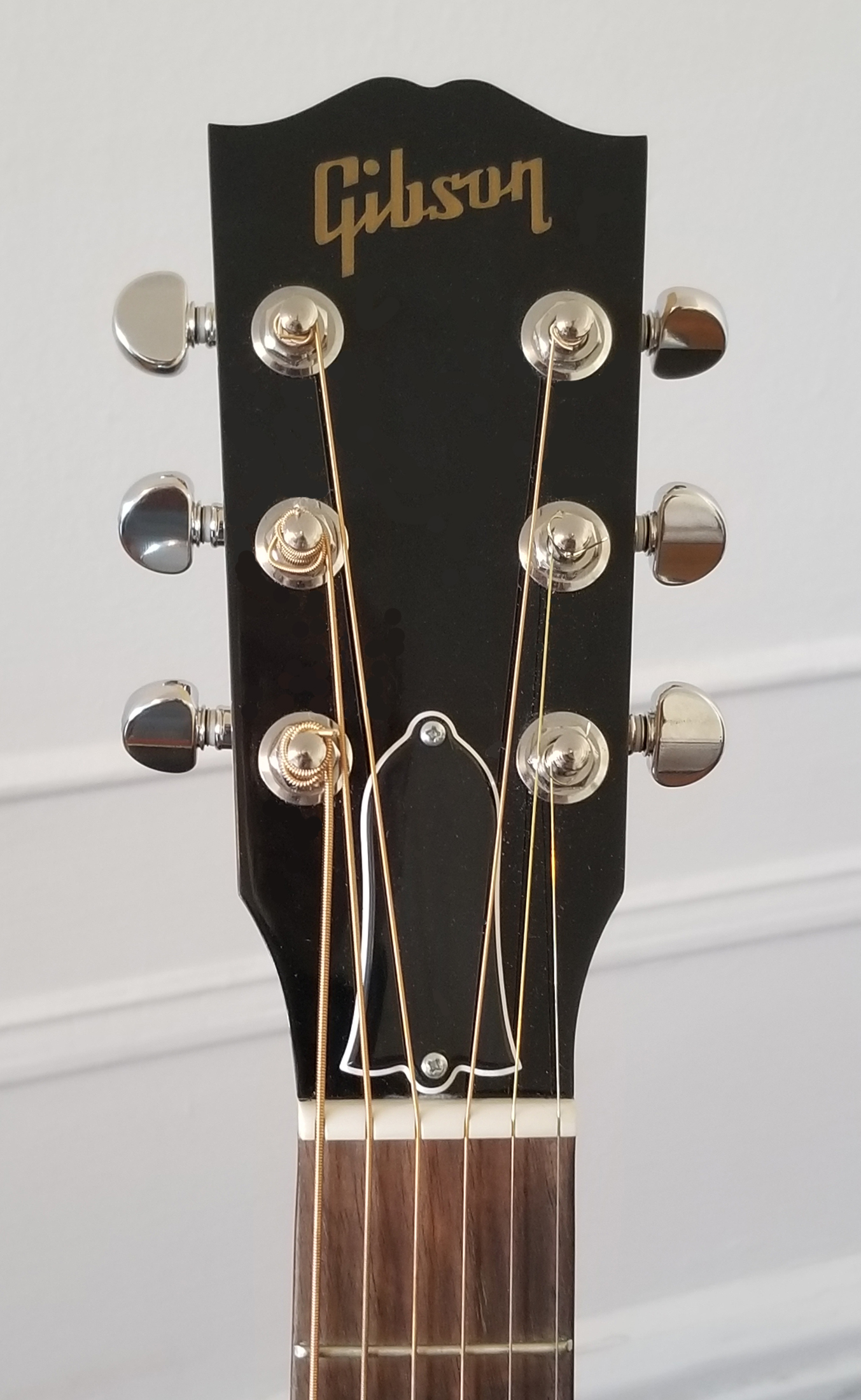 |
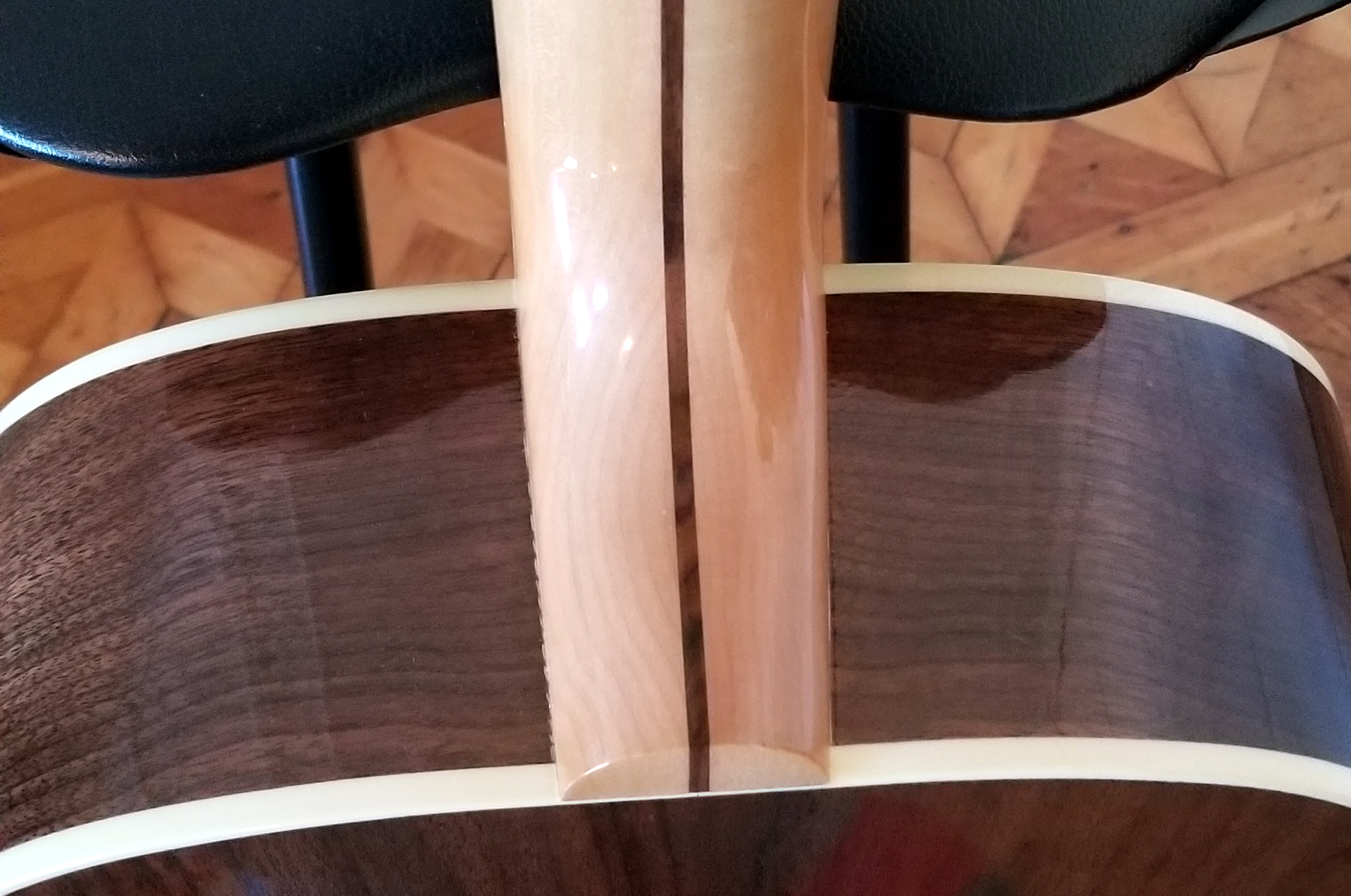 |
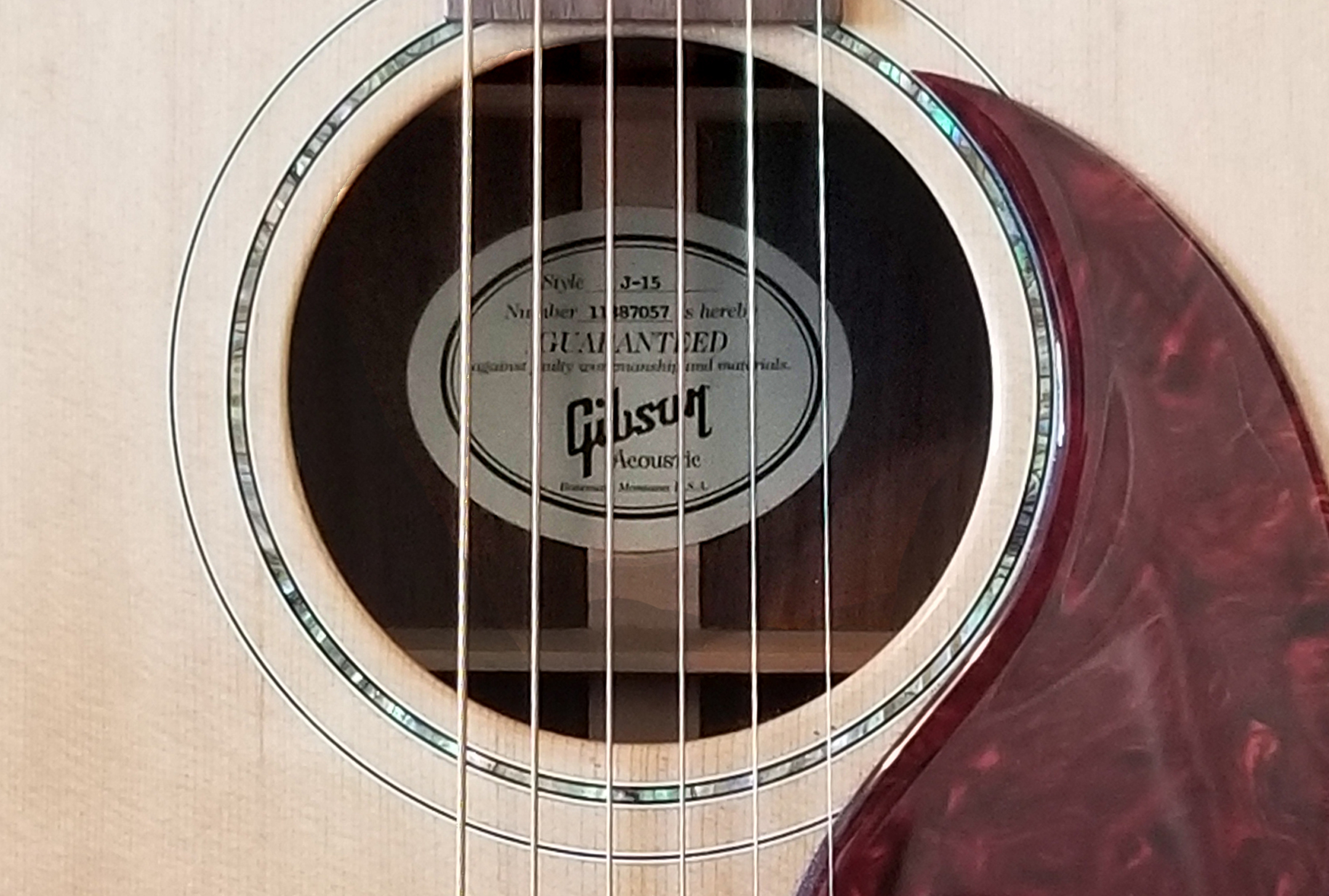 |
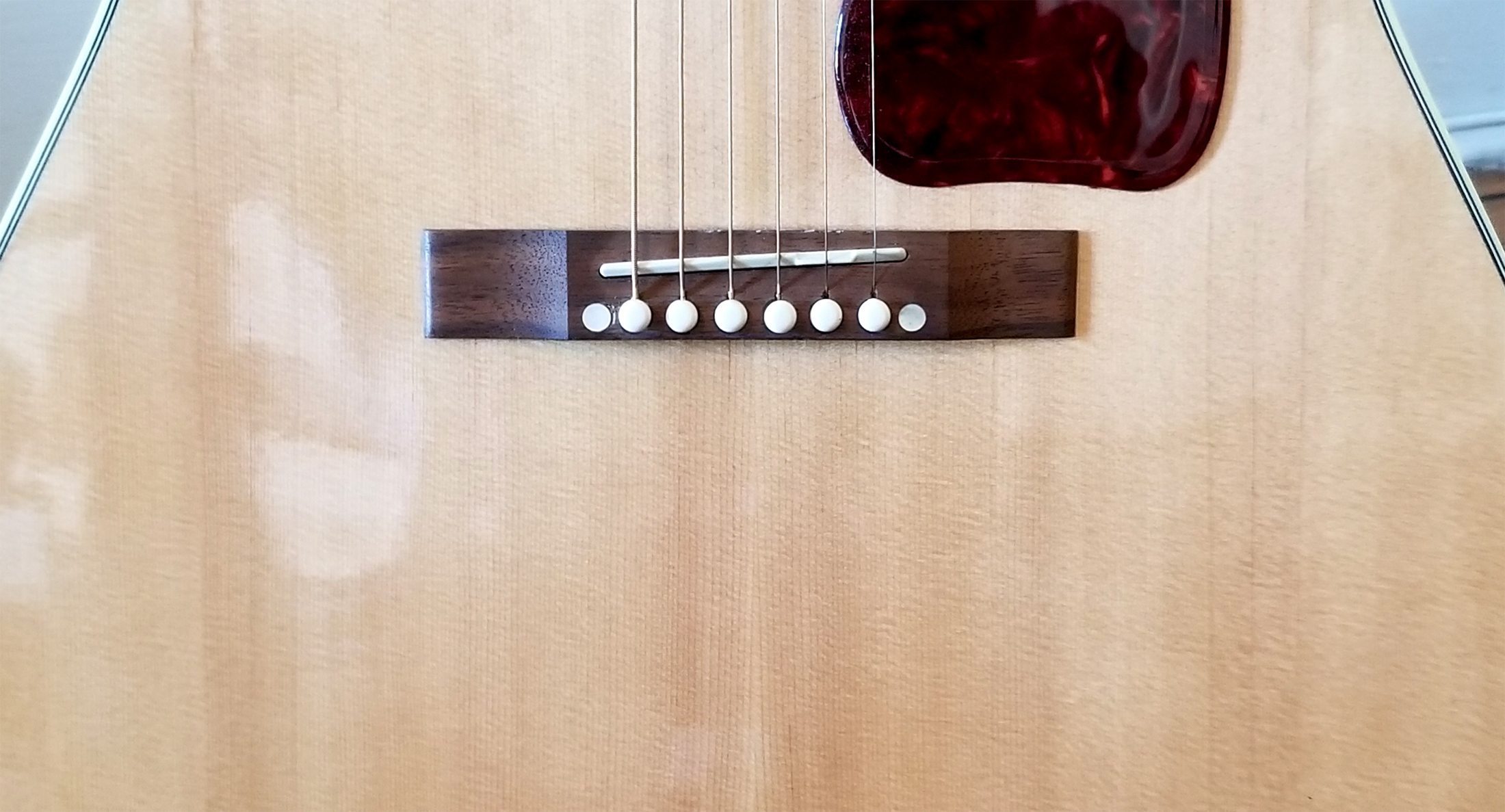 |
The Gibson J-15 is indeed a professional-level acoustic guitar with the same high-quality construction features of its more expensive sibling, the J-45. These include a traditional dovetail neck joint that is attached using hot hide glue, just like they have been doing at Gibson for a hundred years or more.
The J-15 also has hand-scalloped bracing under the top for maximized resonance and responsiveness to nuanced playing, while being strong enough to take the most robust strums from the thickest picks. The finish of nitrocellulose lacquer, hand-sprayed and buffed out to protect the plates of thin walnut and spruce, allows the tonewood to breathe and flex as the sound-producing energy passes through it on its way to becoming beautiful music. And like the tonewoods themselves, the finish will age and help the guitar sound better and better, year after year. The maple neck is also finished in the same high gloss lacquer, a nice perk from the satin finishes found on most guitar necks these days.
Who Doesn’t Love a Lovable Neck?
I will say right up front, this is one of the most effortless acoustic guitar necks made today. It has Gibson’s usual short-scale length, the strings running 24.75” from bridge to nut. And it has Gibson’s modern Slim Taper profile, which is carved quite low, and has a smooth shape as it moves from the bass side to the treble. There is nothing like a cheek or angle or peak to speak of.
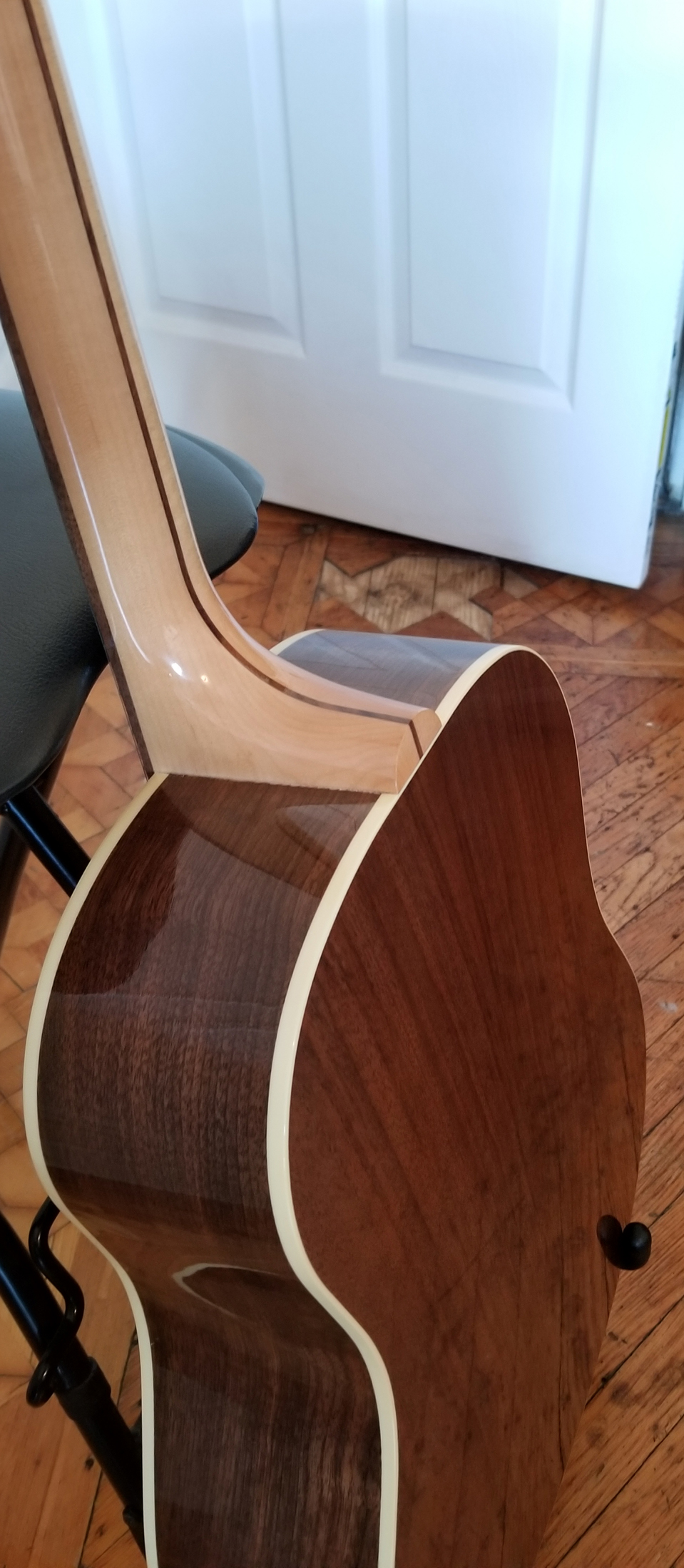 The nut width measures 1.725”, a bit less than today’s industry standard 1.75”, and a very little bit more than the 1-11/16″ measurement used at Gibson through most of the twentieth century, starting in 1947. I assumed it was wider, but the very low planing of the maple neck flattens the palm out more than the Round profile used on older Gibsons, or a V profile from the pre-war days. So, the fingers feel like they are spread a little farther apart when fretting the strings. Overall, it seems roomy but never too roomy.
The nut width measures 1.725”, a bit less than today’s industry standard 1.75”, and a very little bit more than the 1-11/16″ measurement used at Gibson through most of the twentieth century, starting in 1947. I assumed it was wider, but the very low planing of the maple neck flattens the palm out more than the Round profile used on older Gibsons, or a V profile from the pre-war days. So, the fingers feel like they are spread a little farther apart when fretting the strings. Overall, it seems roomy but never too roomy.
The taper of the fingerboard is similar to that used by most guitar makers these days. In other words, it is a little wider down by the head stock where the hand needs it, compared to what was on a 14-fret Gibson in the 1970s. But it has a quicker taper to the fingerboard than on older guitars with wider nuts, so it stays comfortably narrow up near the body.
The fingerboard has a 12” radius, with a little more of a curve to it than guitars with a 16” radius. That too may contribute to the hand feeling less cramped on a relatively narrow neck. Whatever the reason, the combination of features make for very easy playing, fast fingering, and nothing in the way of discomfort.
This, by the way, is the same neck on J-45 Standard and many other contemporary Gibsons in the Modern Acoustic Collection. The J-45 models in the Original Acoustic Collection have the thicker Round neck profile, and their nut widths and fingerboard tapers differ, depending upon the specific model and the era it is based upon.
Uncommon Guitar for the Common Man
The owner of this fine instrument wanted to buy an acoustic guitar that was made in the USA from solid wood. His choice was greatly influenced by Gibson building the J-15 out of domestic tonewoods that are environmentally friendly because they are plentiful and sustainable natural resources that are harvested from tree farms and not requiring the same about of energy to transport as wood coming from across the sea. That also contributes to J-15’s very nice price. And Gibson’s commitment to offering environmentally-friendly guitars has led them to making several other models out of American walnut.
With its walnut back and sides, the tone of the J-15 stands apart from the other Gibson jumbos, and yet, it constantly reminds me of an old dried-out J-50 when banging out bass runs during chord progressions. While it invariably led me to the pick-and-strum style of early Bob Dylan records, the guitar’s owner prefers playing fast and furious rock n roll lead guitar solos. He is an electric guitarist first and foremost. So the low, flat neck and 12″ fretboard radius are very much to his liking.
He also likes the quick projection of the individual notes coming from his J-15 and how his Gibson acoustic guitar responds to different levels of attack, imparting differences in its tone, which he does not get to experience when playing his Gibson SG, or his Tele or Strat for that matter. In its own right, or as an alternative to other guitars in a collection, the walnut/Sitka tone of the J-15 is delightful, in my estimation. And the owner of this J-15 enjoys its tone very much too.
A thoroughly-professional level acoustic guitar, the Gibson J-15 has many features of pricier models. Easy to play and easy going on the ears, this well-designed acoustic guitar has an open and airy sound that is not be as full and robust as heard from the loftier J-45, but that is part of its appeal. The J-15 has an agile voice with a combination of tonal properties heard only from walnut. Articulate without being strident, the woolly warmth fleshing out the quintessentially “Gibson” hollow log thunk in the bass is complimented by a dry and punchy mid-range, cheerful trebles, and angelic high harmonics with the subtle yet complex coloring unique to that particular tonewood. It should appeal to people who love the Gibson acoustic guitar sound, and those seeking a short-scale guitar with a large sound chamber and mellow tone that is different yet traditional at the same time.
And that is one man’s word on…
The Gibson J-15 Standard
List Price: $1,799. 00 or ask your Gibson dealer for their Best Price!
